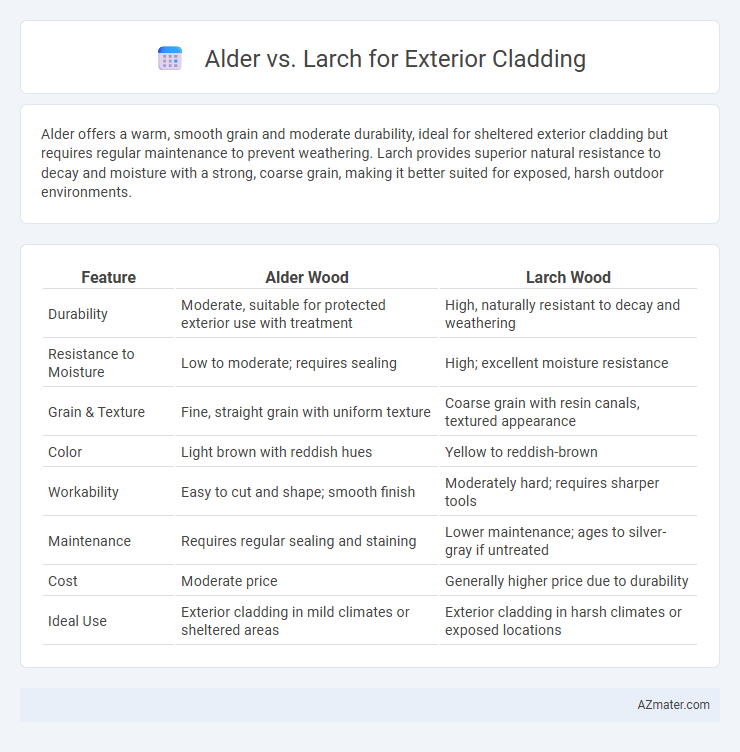Alder offers a warm, smooth grain and moderate durability, ideal for sheltered exterior cladding but requires regular maintenance to prevent weathering. Larch provides superior natural resistance to decay and moisture with a strong, coarse grain, making it better suited for exposed, harsh outdoor environments.
Table of Comparison
| Feature | Alder Wood | Larch Wood |
|---|---|---|
| Durability | Moderate, suitable for protected exterior use with treatment | High, naturally resistant to decay and weathering |
| Resistance to Moisture | Low to moderate; requires sealing | High; excellent moisture resistance |
| Grain & Texture | Fine, straight grain with uniform texture | Coarse grain with resin canals, textured appearance |
| Color | Light brown with reddish hues | Yellow to reddish-brown |
| Workability | Easy to cut and shape; smooth finish | Moderately hard; requires sharper tools |
| Maintenance | Requires regular sealing and staining | Lower maintenance; ages to silver-gray if untreated |
| Cost | Moderate price | Generally higher price due to durability |
| Ideal Use | Exterior cladding in mild climates or sheltered areas | Exterior cladding in harsh climates or exposed locations |
Introduction: Comparing Alder and Larch for Exterior Cladding
Alder and larch are popular wood choices for exterior cladding, each offering distinct benefits for durability and appearance. Alder provides a smooth texture and warm, reddish-brown tones, while larch is known for its exceptional resistance to decay and knotty, rustic charm. Selecting between alder and larch depends on climate exposure, maintenance preferences, and aesthetic goals for the building facade.
Wood Characteristics: Alder vs Larch
Alder wood features a fine, uniform texture with a straight grain, making it easy to work with and ideal for smooth exterior cladding finishes. Larch wood stands out for its exceptional durability and high resin content, offering natural resistance to decay and weathering in exterior applications. While alder provides a warm, reddish-brown hue that ages gracefully, larch delivers a rich golden tone that darkens over time, enhancing outdoor durability and visual appeal.
Durability and Weather Resistance
Alder wood, while offering moderate durability, is less resistant to harsh weather conditions compared to Larch, which boasts high natural resin content providing superior decay resistance and toughness against moisture. Larch's dense grain structure enhances its performance in exterior cladding applications by preventing warping and rot over time. For long-term exposure to elements, Larch is typically preferred due to its proven ability to withstand varying weather without compromising structural integrity.
Aesthetic Differences: Color and Grain
Alder exterior cladding showcases a warm, reddish-brown hue with a smooth, fine grain that offers a uniform and subtle texture, enhancing modern and rustic architectural styles. Larch, by contrast, presents a more varied color palette ranging from golden yellows to rich reddish-browns, coupled with a pronounced, coarse grain pattern that adds natural character and visual depth to facades. These aesthetic differences make alder ideal for sleek, contemporary designs while larch suits projects seeking a rustic, textured appearance with dynamic color variations.
Maintenance Requirements
Alder wood requires periodic sealing or staining every 2-3 years to prevent weathering and preserve its warm, reddish-brown color when used for exterior cladding. Larch wood naturally contains resins that increase its resistance to decay, allowing for lower maintenance needs, though occasional cleaning and re-sealing every 4-5 years are recommended. Both woods benefit from protection against moisture and UV exposure to extend their lifespan and maintain aesthetic appeal.
Environmental Impact and Sustainability
Alder wood, sourced primarily from fast-growing, renewable forests, offers a lower environmental footprint due to its rapid regeneration and minimal chemical treatment requirements for exterior cladding. Larch, known for its natural durability and resistance to decay, reduces the need for synthetic preservatives, enhancing sustainability in exterior applications. Both woods contribute to carbon sequestration, but larch's higher density and longevity typically result in a more favorable lifecycle assessment for eco-friendly building projects.
Cost Comparison: Alder vs Larch
Alder wood generally costs less than larch, making it a budget-friendly choice for exterior cladding projects. Larch is typically priced higher due to its superior durability and natural resistance to decay and insects, which can reduce long-term maintenance costs. When considering cost-efficiency over time, larch may offer better value despite the higher initial investment.
Installation Considerations
Alder wood offers smooth texture and ease of cutting, making it simpler for precise installation in exterior cladding applications. Larch is denser and more resinous, requiring specialized tools and treatment for effective fastening and long-term durability. Proper sealing and spacing are critical for both woods to prevent moisture infiltration and ensure structural integrity in exterior settings.
Common Applications in Exterior Design
Alder wood is frequently chosen for exterior cladding in residential projects due to its fine grain and smooth texture, providing a warm and natural aesthetic ideal for siding and trim. Larch, known for its durability and high resin content, is commonly used in exterior design for weather-resistant cladding, decking, and garden structures, especially in harsh climates. Both woods perform well in exterior applications, with larch favored for long-term exposure and alder selected for stylish, moderate-exposure facades.
Conclusion: Choosing the Right Wood for Your Project
Alder offers a smooth texture and warm, reddish tones that enhance residential exteriors with a polished, classic look, while Larch stands out for its exceptional durability, natural resistance to decay, and striking grain ideal for rustic, long-lasting cladding. Selecting between Alder and Larch depends on climate exposure and maintenance willingness; Larch performs better in harsh, wet environments due to its dense fibers, whereas Alder requires protective finishes but delivers superior aesthetic warmth. For projects prioritizing longevity and low upkeep, Larch is advantageous, whereas Alder suits designs emphasizing refined appearance and moderate weather conditions.

Infographic: Alder vs Larch for Exterior Cladding
 azmater.com
azmater.com